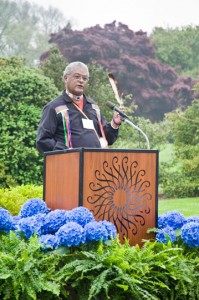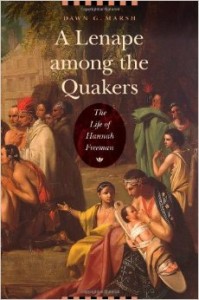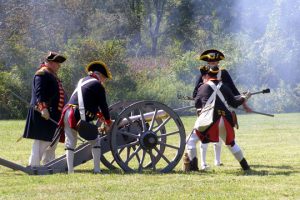Within the past five years, Hannah Freeman, known in local lore by the pejorative name of “Indian Hannah,” has become Chester County’s “in” person of 2014, and an eye-opening book on her life has come along just in time!

On May 15, a large stone marker was re-dedicated at the Chester County Visitor Center near the main entrance to Longwood Gardens. Once located on Route 52 near Longwood, a few hundred yards from Freeman’s cabin birthplace, the marker had been cutoff from public access when Route 52 was re-located in 2011.
The stone marker originally dedicated in 1925, reads in part, “Indian Hannah 1732 – 1802, the last of the Indians in Chester County….”
Enter myth-buster Dawn G. Marsh. (I love Myth Busters.)
On April 30, Marsh, assistant professor of history at Perdue spoke at the Chester County Historical Society focusing on the most important sources used for her new book, “A Lenape Among the Quakers — The Life of Hannah Freeman.”
Marsh’s first major discovery came with the help of Marshall Becker, Professor Emeritus (anthropology) at West Chester University.
“The Examination of Indian Hannah alias Hannah Freeman,” was an interview of Freeman gave on July 28, 1797. In it Freeman gives a narration of her family including her mother Sarah, grandmother Jane, two aunts Betty and Nanny and two younger brothers. Unfortunately, establishing her residency paved the way for her later removal to the poorhouse being built in Newlin Township, where Freeman died and was interred in a Potters Field in 1802.
The examination definitively attests to Freeman’s adaptability. For in addition to wearing European-style clothing, she mentions a recent visit to her aunts where she realizes she had almost forgotten how to speak “Indian” and did not like their manner of living.
Of the 1797 interview Marsh said, “I understood how significant it was to get the voice of a Native American woman.
Marsh’s second discovery was “Kindness Extended,” a contract written in March 1798, a few months after “The Examination.” Signers with now familiar last names like Buffington, Embree, Marshall, Harlan, Pennock and Pyle came together pledging to care for Freeman in her final years when she was plagued with rheumatism and could no longer get around.
Indeed, Hannah Freeman was respected so much by her Quaker neighbors that they entrusted their children to her care. In addition they sought out her healing skills, being more knowledgeable about herbal medicines than doctors of that day who practiced “bleeding” to help balance the four “humours.”
Marsh’s third major discovery was the Albert Cook Myers (1874-1960) collection of interviews of Quakers who knew Hannah Freeman. The collection is now housed at the Chester County Historical Society where Myers was a member.
Marsh criticizes the 1925 Longwood marker as well as one in Newlin Township dedicated in 1909, (recently moved and re-dedicated in 2009) for characterizing Freeman as the last of the Lenni-Lenape people.
“Hannah Freeman was not the last of her kind,” Marsh emphasized.
“This was part of the myth created by the settler population that forced out the original population,” Marsh explained. “Within a generation of her death, she was  romanticized and entered into legend as an artifact of the past”.
romanticized and entered into legend as an artifact of the past”.
According to Marsh, this fantasy helped turn-of-the century Americans put “the Indian problem” in the past.
In addition, Marsh takes exception with a popular 1909 poem written by John Russell Hayes (1866-1945) that includes the lines “last of her race.” The poem was read at the 2009 re-dedication of the Newlin marker and indeed at Wednesday’s re- dedication of the Longwood marker.
According to Marsh, “Hayes’ poem reflected the popular sentiment legitimized by late 19th century historians and anthropologists who confidently embraced the rhetoric of conquest and racial superiority.”
“A Lenape Among the Quakers” is an absolute must read and a passionate narrative of a remarkable Native American woman. It is available through Amazon, Barnes & Noble or the museum store at the Chester County Historical Society.
(Featured photo: A recreation of the photo taken in 1925 when the Hannah Freeman monument was originally dedicated.)
About Sally Denk Hoey
Sally Denk Hoey, is a Gemini - one part music and one part history. She holds a masters degree cum laude from the School of Music at West Chester University. She taught 14 years in both public and private school. Her CD "Bard of the Brandywine" was critically received during her almost 30 years as a folk singer. She currently cantors masses at St Agnes Church in West Chester where she also performs with the select Motet Choir. A recognized historian, Sally serves as a judge-captain for the south-east Pennsylvania regionals of the National History Day Competition. She has served as president of the Brandywine Battlefield Park Associates as well as the Sanderson Museum in Chadds Ford where she now curates the violin collection. Sally re-enacted with the 43rd Regiment of Foot and the 2nd Pennsylvania Regiment for 19 years where she interpreted the role of a campfollower at encampments in Valley Forge, Williamsburg, Va., Monmouth, N.J. and Lexington and Concord, Mass. Sally is married to her college classmate, Thomas Hoey, otherwise known as "Mr. Sousa.”



Comments